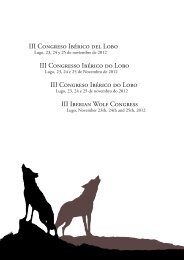Bison-Rewilding-Plan-2014
Bison-Rewilding-Plan-2014
Bison-Rewilding-Plan-2014
- No tags were found...
Create successful ePaper yourself
Turn your PDF publications into a flip-book with our unique Google optimized e-Paper software.
RUUD MAASKANT / ARK NATURE2.2 Ecology of the European bisonThe European bison is one of the largest terrestrialmammals in Europe; the weight of adultmales ranges from 530–840 kg in the wild (RafalKowalczyk, personal communication, <strong>2014</strong>). Femalesare smaller, weighing 320–540 kg (Krasinska,2007, 2008; Stachurski 2003). They are sexuallydimorphic, with the bulls having heavier heads andbigger humps than cows. Both males and femaleshave horns and use them for fighting, although thebull’s horns are thicker and wider and set furtherapart.2.2.1 Social structure andreproductionFree-living bison are known to form larger herds inwinter when they are fed through feeding stationsand so congregate around this artificial foodsource. Groups of bison do not form family unitsand mixed groups are the basic units for a bisonpopulation, comprising cows, juvenile males andfemales aged two to three, calves and occasionallyadult bulls. The average group size is 20 individuals.These herds stay together until spring when thefirst grasses and herbs appear, usually towards theend of April. The large winter herds then split intosmaller ones of 12 animals on average, comprisingcows with their calves and subadult males andfemales. Adult males become either solitary (60%of males) or form small groups of two to three bullsand only during the rutting season from August toOctober do they join the larger groups. Such groupsgraze and browse all day long in the area of theirchoice, but do not appear to want to defend it. Thisis why such mixed groups frequently meet eachother and animals can transfer from one group toanother. The composition of the group is thus notfirmly defended. In the summer there is plenty ofnatural food, so the bison do not compete for food(Stachurski 2003).The size and structure of mixed groups arechangeable, some changes being seasonal (calving,joining of bulls in the rutting period), whileothers are behavioural. Groups meet frequently,combine and then quickly split, exchanging some12



